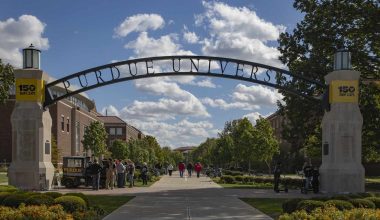In the world of higher education, few phrases evoke a sense of tradition and prestige quite like “Red Brick Universities.” Coined in the early 20th century, this term refers to a group of UK universities known for their distinctive red brick buildings, which symbolize their modernity and status as institutions of higher learning.
Today, these universities continue to attract top students and faculty from around the world and are home to some of the most groundbreaking research and innovative teaching methods in academia. This article will explore some amazing facts about Red Brick Universities and discover what makes these institutions unique.

Table of contents
- What Are Red Brick Universities?
- Amazing Facts About Red Brick Universities
- The term “Red Brick” was Originally Derogatory
- Red Brick Universities Played A Crucial Role In Expanding Higher Education
- Red Brick Universities Have Produced Many Notable Alumni
- Red Brick Universities Have A Strong Focus On Research
- Red Brick Universities Have A Diverse Student Body
- Red Brick Universities Are Known For Their Beautiful Campuses
- What Are The Best Red Brick Universities?
- Frequently Asked Questions
- References
- Recommendations
What Are Red Brick Universities?
Red Brick Universities is a term used to describe a group of universities established in the late 19th and early 20th centuries in the United Kingdom. These universities are distinctive red brick buildings constructed during unprecedented growth and expansion in higher education in the UK.
The term “Red Brick” was first coined in the early 20th century to distinguish these new universities from the older, more established institutions such as Oxford and Cambridge, which were the “Ancient” or “Ivy League” universities. The Red Brick universities were a new breed of institution founded on the principles of modernity, innovation, and accessibility.
The origins of the Red Brick universities run back to the 1850s when a series of government reports highlighted the need for expanded access to higher education in the UK. At the time, university education was primarily the preserve of the wealthy and privileged, with only a small percentage of the population able to attend.
Several new institutions were established in response to this need, focusing on science and technology. These universities included the University of Manchester, Birmingham, Leeds, Liverpool, Sheffield, and Bristol, all founded between 1881 and 1904.
A commitment to academic excellence and a focus on research and innovation characterized the Red Brick universities. They were also notable for their commitment to social mobility, with many of these institutions offering scholarships and bursaries to students from disadvantaged backgrounds.
Over time, the Red Brick universities continued to evolve and expand, with many now ranked among the top universities in the world. They remain a symbol of the UK’s long and proud tradition of higher education and a testament to the enduring importance of innovation and progress in academia.
Also read:15 Best Small California Colleges in 2023 | Apply Now
Amazing Facts About Red Brick Universities
The term “Red Brick” refers to the characteristic red-brick architecture of the buildings on these campuses. Here are some amazing facts about Red Brick Universities:
The term “Red Brick” was Originally Derogatory
“Red Brick” was initially used as a derogatory term to describe the universities in the late 19th and early 20th centuries. It distinguished these universities from the ancient universities of Oxford and Cambridge, which were more prestigious. However, the term has become a badge of honor for these universities over time.
Red Brick Universities Played A Crucial Role In Expanding Higher Education
Red Brick Universities were crucial in expanding higher education in the United Kingdom. Before the founding of these universities, higher education was primarily the preserve of the wealthy elite. However, the Red Brick Universities focused on providing higher education for the working and middle classes. This led to a significant expansion of higher education in the UK.
Red Brick Universities Have Produced Many Notable Alumni
Red Brick Universities have produced many notable alums in various fields. For example, the University of Leeds has produced seven Nobel laureates, including Sir William Henry Bragg and his son Sir Lawrence Bragg, who won the Nobel Prize in Physics in 1915. The University of Birmingham has produced four Nobel laureates, including Sir Paul Nurse, who won the Nobel Prize in Physiology or Medicine in 2001.
Red Brick Universities Have A Strong Focus On Research
Red Brick Universities have a strong focus on research. Many are members of the Russell Group, 24 leading research-intensive universities in the UK. These universities are responsible for producing a significant proportion of the research output in the UK, and they are also responsible for training a large number of Ph.D. students.
Red Brick Universities Have A Diverse Student Body
Red Brick Universities have a diverse student body, and many of them have a large number of international students. This diversity reflects in the wide range of courses and student societies, and clubs available at these universities.
Red Brick Universities Are Known For Their Beautiful Campuses
Red Brick Universities are known for their beautiful campuses, often featuring stunning red-brick buildings and landscaped gardens. Design for most of these campuses was by leading architects and landscapers, providing a peaceful and inspiring environment for students to study and socialize.
Finally, Red Brick Universities have played a significant role in expanding higher education in the UK and remain important research and innovation centers. With its diverse student body and beautiful campuses, they offer a unique and inspiring environment for students to learn and grow.
What Are The Best Red Brick Universities?
Here are some of the best red brick universities:
#1. University of Birmingham
The University of Birmingham has a stellar reputation and consistently ranks as one of the top universities in the UK and the world. It is a member of the prestigious Russell Group of research-intensive universities in the UK. It is ranked in the top 100 universities in the world by the Times Higher Education World University Rankings.
The University of Birmingham is a diverse and inclusive community with over 150 nationalities. It is committed to promoting equality, diversity, and inclusion and has received recognition for its efforts.
The University of Birmingham is at the forefront of innovation and entrepreneurship, with several programs and initiatives designed to support students and staff in developing their ideas and turning them into successful businesses. The University’s Innovation Centre and B-Enterprising program support startups and entrepreneurs, while the B-STEM program encourages women to pursue careers in science, technology, engineering, and mathematics.
#2. University of Bristol
The University of Bristol is a prestigious red brick university in Bristol, England. It has built a reputation for being one of the best universities in the United Kingdom and the world.
Bristol is known for its research strengths in various fields, including engineering, medicine, social sciences, and arts and humanities. It has over 40 research centers and institutes and is home to several world-renowned research groups.
Bristol is consistently rated highly by its students, with a 90% satisfaction rating in the National Student Survey. The University provides an excellent learning environment with state-of-the-art facilities.
#3. University of Leeds
The University of Leeds is a world-renowned research-intensive institution located in the vibrant and diverse city of Leeds in the north of England. Founded in 1904, it is one of the so-called “red brick universities” – a group of prestigious UK universities founded in the late 19th and early 20th centuries known for their red-brick architecture.
The University of Leeds has recently invested heavily in its facilities, with state-of-the-art research facilities, teaching spaces, and accommodation. The University is home to world-class research centers like the Leeds Institute for Data Analytics and the Astbury Centre for Structural Molecular Biology.
Leeds is a truly global institution with a diverse student body and partnerships with universities and institutions worldwide.
#4. University of Liverpool
The University of Liverpool is a leading research-intensive institution located in the vibrant and culturally rich city of Liverpool, northwest of England. Established in 1881, it is one of the six original “red brick” universities.
The University of Liverpool is home to eight Nobel Prize winners, including Ronald Ross (Physiology or Medicine, 1902), Sir Charles Sherrington (Physiology or Medicine, 1932), and Sir James Chadwick (Physics, 1935).
The institution has a diverse population of over 35,000 students from over 100 countries. The University is also home to one of the largest international student communities in the UK.
Also read: Private Universities In Georgia In 2023 | Apply Now
#5. University of Manchester
The University of Manchester is one of the best red brick universities because of its strong academic reputation. It consistently ranks highly in international university rankings, such as the QS World University and Times Higher Education World University Rankings. It is also highly regarded for its research excellence, with a significant proportion of its research rated as world-leading or internationally excellent in the latest Research Excellence Framework (REF) assessment.
The University played a significant role in the women’s suffrage movement in the UK, with suffragette leader Emmeline Pankhurst serving as a member of the University’s staff. It has a long history of producing Nobel laureates, with 25 laureates affiliated with the institution. This includes notable figures such as physicist Ernest Rutherford and economist Joseph Stiglitz.
#6. University of Sheffield
The University of Sheffield is a world-renowned research institution with strengths in engineering, science, medicine, and social sciences. It is home to over 50 interdisciplinary research institutes and centers, including the Sheffield Institute for Translational Neuroscience (SITraN) and the Grantham Centre for Sustainable Futures.
The University of Sheffield is in the heart of Sheffield. Its campus is across several sites, including the stunning red-brick buildings of the Victorian-era Western Bank campus and the modern, purpose-built Diamond building.
The University of Sheffield has an excellent track record for graduate employability, with 97.2% of graduates in employment or further study six months after graduation, according to the Destination of Leavers from Higher Education survey.
#7. University of Warwick
The University of Warwick is a public research university in Coventry, England. It was founded in 1965 and is one of the youngest universities in the prestigious Russell Group, a consortium of leading research-intensive UK universities. It has a reputation for academic excellence, research quality, and innovation, making it one of the best red brick universities.
The University is renowned for its research excellence, with over 90% of its research output rated as ‘world-leading’ or ‘internationally excellent’ in the most recent Research Excellence Framework (REF) assessment. It has several research centers, including the Warwick Manufacturing Group, the Institute of Digital Healthcare, and the Warwick Business School.
The University’s campus is one of the largest and most attractive in the UK, with state-of-the-art facilities and green spaces. It features modern buildings designed by renowned architects, including Arup Associates and Allies and Morrison.
The University is home to one of the largest arts centers in the UK, the Warwick Arts Centre. It features a cinema, theater, concert hall, and art gallery and hosts diverse cultural events throughout the year.
Frequently Asked Questions
Red Brick universities are a group of six British universities founded in the late 19th and early 20th centuries. These universities were known for their distinctive red brick buildings and for providing the growing urban population with higher education opportunities.
The six universities commonly referred to as Red Brick universities are the University of Birmingham, the University of Bristol, the University of Leeds, the University of Liverpool, the University of Manchester, and the University of Sheffield.
They are called Red Brick universities because of their distinctive red brick buildings. These buildings differed from the traditional Gothic architecture of older universities like Oxford and Cambridge.
Red Brick universities were established in the late 19th and early 20th centuries.
One interesting fact is that Red Brick universities were to provide higher education opportunities to the growing urban population. Another interesting fact is that many famous alums have attended Red Brick.
Red Brick universities are still highly regarded for their academic excellence and research contributions. They continue to attract students worldwide and rank among the top universities in the UK.
Conclusions
Overall, red brick universities remain a cornerstone of higher education in the UK, and their legacy continues to inspire and shape the country’s education landscape. Whether you’re a student, a researcher, or an alum, these institutions offer a unique and enriching experience that can profoundly impact your personal and professional development.




